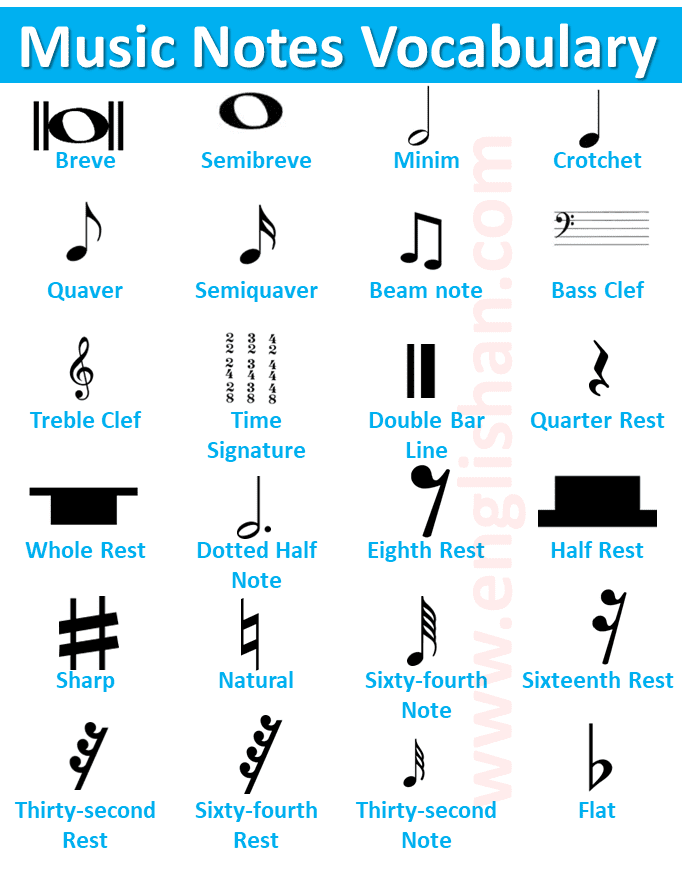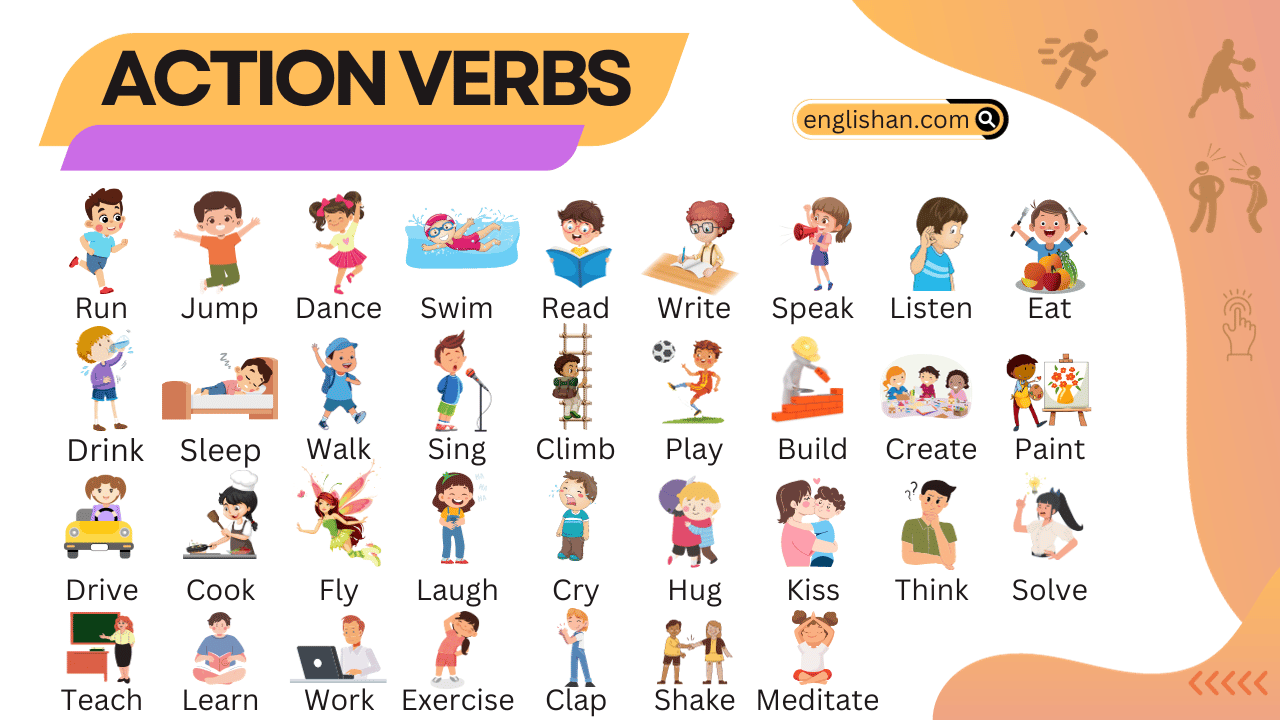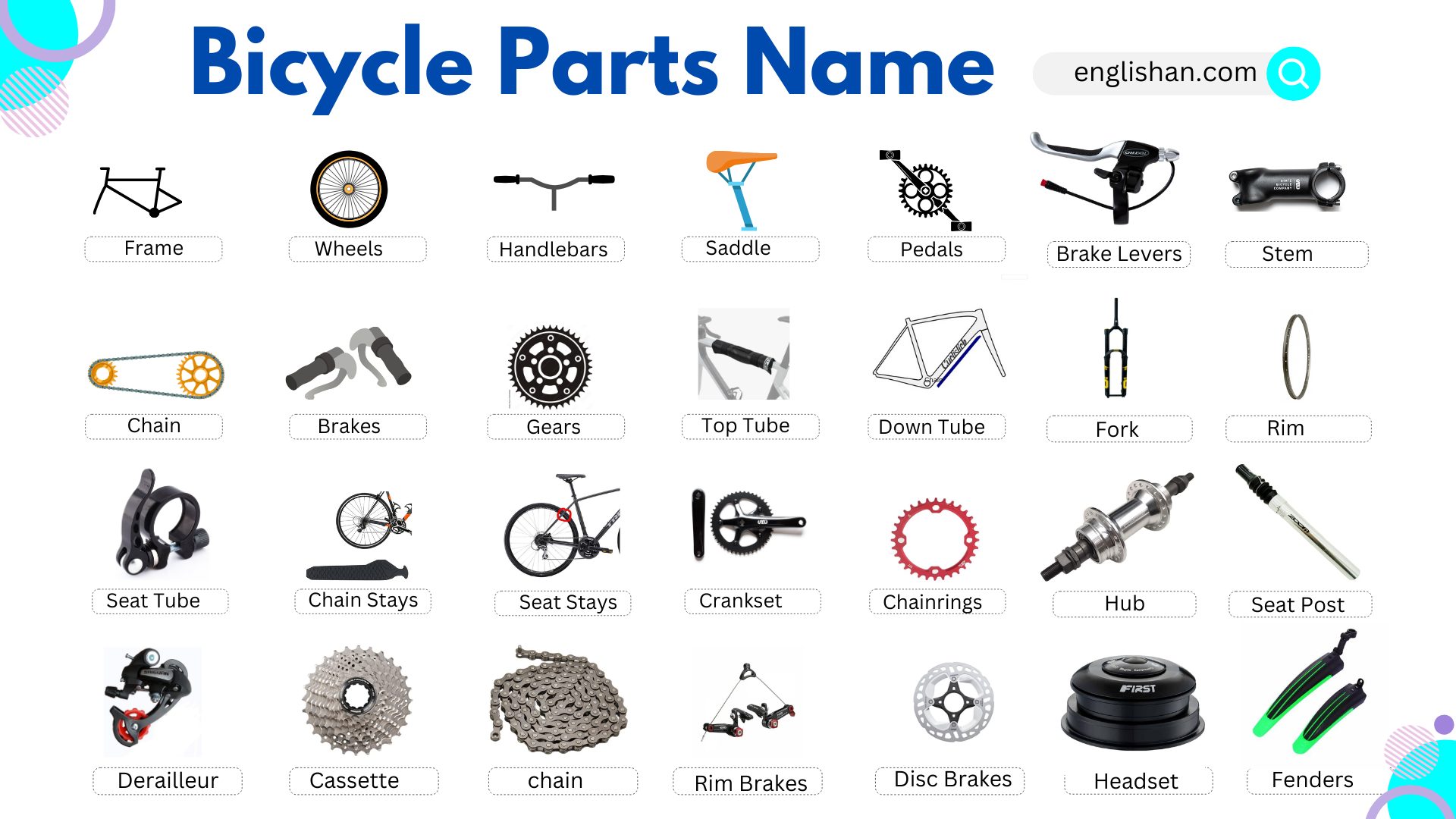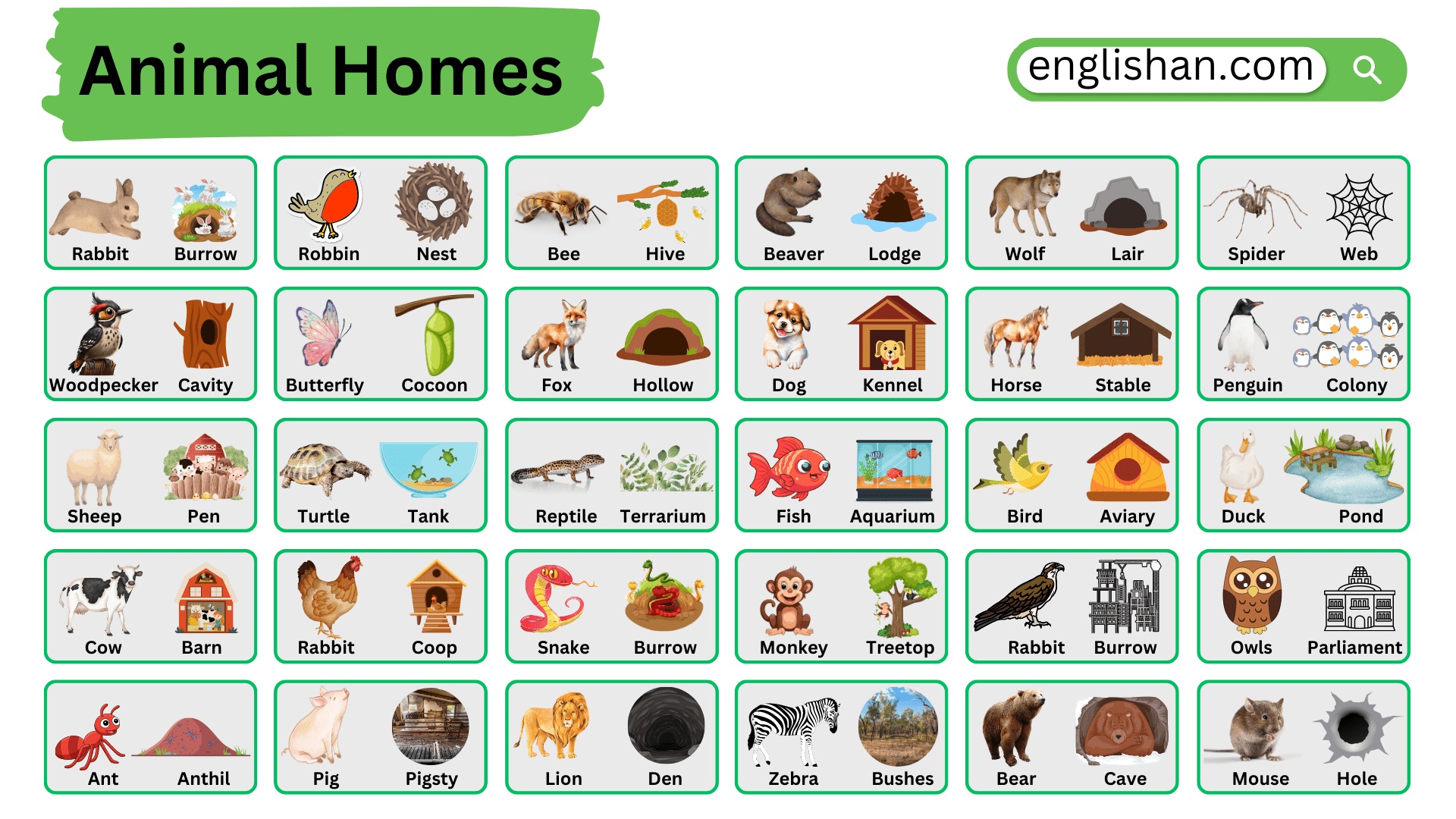Contents
In this blog post, we will help you learn the names of music notes and their corresponding HTML codes in English. Understanding these is essential for creating web content that includes musical symbols or learning about music notation. This information will make it easier to use music-related symbols in various digital formats.
To learn more vocabulary on different topics, visit our Vocabulary Category.
Music Notes Names with HTML Codes
| S.No | Music Note Name | Symbol | HTML Code |
|---|---|---|---|
| 1 | Quarter Note | ♩ | ♩ |
| 2 | Eighth Note | ♪ | ♪ |
| 3 | Beamed Eighth Notes | ♫ | ♫ |
| 4 | Beamed Sixteenth Notes | ♬ | ♬ |
| 5 | Musical Flat Sign | ♭ | ♭ |
| 6 | Musical Natural Sign | ♮ | ♮ |
| 7 | Musical Sharp Sign | ♯ | ♯ |
| 8 | Whole Note (Semibreve) | 𝅝 | 𝅝 |
| 9 | Half Note (Minim) | 𝅗𝅥 | 𝅗𝅥 |
| 10 | Quarter Note (Crotchet) | 𝅘𝅥 | 𝅘𝅥 |
| 11 | Eighth Note (Quaver) | 𝅘𝅥𝅮 | 𝅘𝅥𝅮 |
| 12 | Sixteenth Note (Semiquaver) | 𝅘𝅥𝅯 | 𝅘𝅥𝅯 |
| 13 | Thirty-Second Note (Demisemiquaver) | 𝅘𝅥𝅰 | 𝅘𝅥𝅰 |
| 14 | Sixty-Fourth Note (Hemidemisemiquaver) | 𝅘𝅥𝅱 | 𝅘𝅥𝅱 |
| 15 | One Hundred Twenty-Eighth Note | 𝅘𝅥𝅲 | 𝅘𝅥𝅲 |
| 16 | Double Sharp | 𝄪 | 𝄪 |
| 17 | Double Flat | 𝄫 | 𝄫 |
| 18 | Common Time (C) | 𝄴 | 𝄴 |
| 19 | Cut Time (C with a vertical line) | 𝄵 | 𝄵 |
| 20 | Fermata (above) | 𝄐 | 𝄨 |
| 21 | Fermata (below) | 𝄑 | 𝄩 |
| 22 | C Clef (Alto Clef) | 𝄡 | 𝄱 |
| 23 | G Clef (Treble Clef) | 𝄞 | 𝄲 |
| 24 | F Clef (Bass Clef) | 𝄢 | 𝄳 |
| 25 | Breath Mark (comma) | 𝆑 | 𝆁 |
| 26 | Caesura (two diagonal lines) | 𝄬 | 𝄬 |
| 27 | Coda | 𝄌 | 𝄤 |
| 28 | Dal Segno (D.S.) | 𝄋 | 𝄣 |
| 29 | Da Capo (D.C.) | 𝄊 | 𝄢 |
| 30 | Segno | 𝄈 | 𝄠 |
| 31 | Turn | 𝄐 | 𝄨 |
| 32 | Trill | 𝓉𝓇 | No specific HTML code; use individual letters and style. |
| 33 | Mordent (inverted) | 𝄰 | 𝄺 |
| 34 | Mordent | 𝄱 | 𝄻 |
| 35 | Pedal down (Ped.) | 𝄐 | 𝄨 |
| 36 | Pedal up (asterisk) | * | * |
| 37 | Accent (above) | 𝆑 | 𝆁 |
| 38 | Tenuto | — | — |
| 39 | Repeat Open (begin) | 𝄆 | 𝄦 |
| 40 | Repeat Close (end) | 𝄇 | 𝄧 |
| 41 | Up Bow (for string instruments) | 𝆪 | 𝆊 |
| 42 | Down Bow (for string instruments) | 𝆫 | 𝆇 |
| 43 | Repeat 1 bar | 𝄡 | 𝄱 |
| 44 | Repeat 2 bars | 𝄢 | 𝄳 |
| 45 | Repeat 4 bars | 𝄣 | – |
| 46 | Triplet numeral (3) | (𝟹) | Use standard numeral in parentheses. |
| 47 | Crescendo (hairpin opening) | < | < |
| 48 | Diminuendo (hairpin closing) | > | > |
| 49 | Staccatissimo (wedge) | 𝆬 | 𝆌 |
| 50 | Grace note slash | 𝅭 | 𝅭 |

Uses of Music Notes Symbols
- ♩ (Quarter Note) – Represents a single beat in most time signatures.
- ♪ (Eighth Note) – Represents half a beat.
- ♫ (Beamed Eighth Notes) – Represents two eighth notes beamed together, often used to clarify rhythm.
- ♬ (Beamed Sixteenth Notes) – Represents two sixteenth notes beamed together.
- ♭ (Musical Flat Sign) – Lowers the pitch of a note by a semitone.
- ♮ (Musical Natural Sign) – Cancels a previous flat or sharp, returning the note to its original pitch.
- ♯ (Musical Sharp Sign) – Raises the pitch of a note by a semitone.
- 𝅝 (Whole Note or Semibreve) – Represents four beats in a standard time signature.
- 𝄐 (Fermata) – Hold the note or rest longer than its usual duration.
- 𝄴 (Common Time) – Signifies a 4/4 time signature.
- 𝄵 (Cut Time) – Represents 2/2 time, often used to double the tempo.
- 𝄞 (Treble Clef or G Clef) – Indicates the position of the note G on the staff.
- 𝄢 (Bass Clef or F Clef) – Indicates the position of the note F on the staff.
- 𝄪 (Double Sharp) – Raises the pitch of a note by two semitones.
- 𝄫 (Double Flat) – Lowers the pitch of a note by two semitones.
- 𝄌 (Coda) – Signifies a passage that brings a piece (or a movement within a piece) to its conclusion.
- 𝄋 (Dal Segno) – Indicates to repeat back to a sign placed earlier in the score.
- 𝄊 (Da Capo) – Means “from the beginning” and indicates to return to the beginning of the piece.
- 𝄬 (Caesura) – A complete pause in music, also known as a “railroad tracks” pause.
- < (Crescendo) – Gradually get louder.
- (Diminuendo) – Gradually get softer.
- 𝄆 (Repeat Open) – Indicates the start of a section to be repeated.
- 𝄇 (Repeat Close) – Signifies the end of a section to be repeated. When paired with the Repeat Open sign, it shows which portion of the music should be played again.
- 𝄈 (Segno) – A sign that, in conjunction with Dal Segno, directs the player to return to the point where the sign is placed.
- 𝄐 (Turn) – Instructs the musician to play the note, play the note above it, return to the original note, play the note below it, and then return to the original note.
- 𝓉𝓇 (Trill) – Rapidly alternate between the written note and the note above it.
- 𝄰 (Mordent) – Quick alternation between the note and the note below, returning to the written note.
- 𝄱 (Inverted Mordent) – Quick alternation between the note and the note above, returning to the written note.
- — (Tenuto) – Play the note for its full value, or slightly longer. It can also mean to play the note slightly louder.
- 𝆪 (Up Bow for string instruments) – Indicates to pull the bow upward or to the left across the instrument.
- 𝆫 (Down Bow for string instruments) – Indicates to push the bow downward or to the right across the instrument.
- 𝄐 (Pedal down) – Indicates when the sustain pedal of the piano should be pressed down.
- *** (Pedal up)** – Indicates when the sustain pedal of the piano should be released.
- 𝆬 (Staccatissimo) – Play the note sharply and detached, shorter than a regular staccato.
- 𝅭 (Grace Note Slash) – Indicates that the note is a grace note, which is played quickly before the main note.
- 𝄤 (Neutral Clef) – Used for untuned percussion instruments.
- 𝄡 (C Clef or Alto Clef) – Positions the middle line as the note C.
- 𝄢 (Baritone Clef) – Sets the C below middle C on the top line of the staff.
- 𝆑 (Breath Mark) – A slight pause, or “taking a breath”. In wind instruments, it means taking a breath. In other contexts, it’s a brief pause.
- 𝄉 (Grace Note) – A note that is played quickly before the main note, and is not counted in the main rhythm of the piece.
FAQs:
The 7 musical notes are:
1. Do
2. Re
3. Mi
4. Fa
5. Sol
6. La
7. Ti
These notes make up the major scale in music and are often used in both vocal and instrumental music.
The 12 basic music notes are:
1. C
2. C# (or Db)
3. D
4. D# (or Eb)
5. E
6. F
7. F# (or Gb)
8. G
9. G# (or Ab)
10.
11. A# (or Bb)
12. B
These notes cover all the sounds in Western music.
To type the musical note ♪:
1. On Windows:
Hold Alt and type 13 on the numeric keypad.
2. On Mac:
Press Option + 266A.
3. On Phones/Tablets:
Use the emoji keyboard to find the musical note symbol.
To read a music note:
1. Staff: Music is written on five lines.
2. Clef: Shows if the notes are high (treble) or low (bass).
3. Notes: Treble lines: E, G, B, D, F
Bass lines: G, B, D, F, A
4. Note values: Whole note = 4 beats
Half note = 2 beats
Quarter note = 1 beat
Eighth note = ½ beat
This helps you know which note to play and for how long!
The 🎶 symbol is the musical note emoji. It represents music and is used to show something related to music.
You May Also Like






